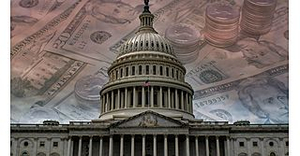Gold and Silver Industry & Investing News
Today’s gold and silver market news, curated from the best of GoldSilver's team and around the web. Everything precious metals investors need to know including updates on big price swings, macro analysis, and breaking stories. Check back often or subscribe to get the highlights in your inbox. Monitor live spot prices on our charts page.
TOP NEWSBreaking: Fed Plans Fewer Rate Cuts in 2025
 Fed's hawkish stance, government shutdown concerns, and Saxo Bank's bullish silver outlook shape this week's precious metals landscape.
Fed's hawkish stance, government shutdown concerns, and Saxo Bank's bullish silver outlook shape this week's precious metals landscape.
Silver Set to Skyrocket: The Gold-Silver Ratio's STORED ENERGY - Mike Maloney & Alan Hibbard
Join Mike Maloney and Alan as they uncover the insane undervaluation of silver and what it means for your portfolio.
READ MORE"2025 Could Be The Last Year For GOLD Under $3000" - Alan Hibbard
In this insightful discussion, Alan Hibbard of GoldSilver.com and Kurt Nelson of SummerHaven Investment Management share why 2025 might be a pivotal
READ MOREGovernment Shutdown Looms as Trump-Musk Alliance Sways GOP
A last-minute intervention by Donald Trump and Elon Musk has upended Congressional efforts to avoid a government shutdown. Using social media, they rallied opposition to a bipartisan spending deal, forcing House Speaker Mike Johnson to reconsider the proposal. The episode highlights Musk's growing political influence and previews potential challenges for the incoming Trump administration.
READ MOREFed Cuts Rates, Signals Slower Pace for Future Reductions
The Federal Reserve cut interest rates by 0.25 percentage points to a range of 4.25% to 4.5%, marking its third consecutive rate reduction in 2024. However, Fed Chair Jerome Powell signaled a more cautious approach to future cuts, indicating fewer reductions in 2025. This announcement led to a market reaction, with stock prices falling and Treasury yields surging. The Fed's decision reflects its ongoing efforts to balance economic growth with inflation control.
READ MOREGold's Tug-of-War: Fed Policy vs. Economic Uncertainty
Gold prices edged higher Thursday, recovering from recent lows as traders reassessed the Federal Reserve's latest policy stance. The precious metal's rebound comes amid a complex economic landscape, with investors balancing the Fed's hawkish signals against ongoing geopolitical uncertainties and upcoming U.S. economic indicators.
READ MOREFed's 'New Phase': Balancing Growth and Inflation Concerns
The Federal Reserve has entered a new phase, with Chair Jerome Powell signaling a renewed focus on inflation despite recent rate cuts. After lowering rates by 1 percentage point, the Fed now aims to move cautiously, citing core inflation still above the 2% target. Policymakers have adjusted their rate projections upward for 2025, indicating a more hawkish stance than previously anticipated.
READ MOREUBS Bullish on Gold in 2025
UBS forecasts gold to reach $2,900/oz by the end of 2025, driven by continued central bank accumulation, increased demand for portfolio hedges, and expected lower interest rates. Despite recent price fluctuations, gold has outperformed the S&P 500 this year, and UBS maintains a bullish outlook due to geopolitical uncertainties, potential US dollar weakness, and the Federal Reserve's anticipated rate cuts.
READ MOREThird Time's the Charm: Fed Cuts Rates, Eyes Slower 2025 Pace
The Federal Reserve is set to lower interest rates for the third consecutive time, with a 25-basis point cut expected on December 18. This reduction would bring the federal funds rate to a range of 4.25% to 4.50%, marking a full percentage point decrease since September. However, economists anticipate a slower pace of easing in 2025 due to persistent inflation and economic resilience.
READ MOREHawkish Cut Expected as Fed Navigates Economic Uncertainties
Wednesday's Federal Reserve meeting is anticipated to deliver a "hawkish cut," combining a 0.25% rate reduction with a more cautious stance on future cuts. Factors influencing this outlook include above-target inflation, stronger-than-expected economic growth, and uncertainties surrounding President-elect Trump's fiscal policies. The Fed's updated projections and Chair Powell's comments will be closely scrutinized for insights into the pace of future rate cuts.
READ MOREFed's 2025 Roadmap Keeps Gold Market on Edge
Gold traded near $2,648 per ounce ahead of the Federal Reserve's last policy meeting of 2024. Markets expect another rate cut, but uncertainty surrounds the pace and number of cuts in 2025. Traders are keenly awaiting the Fed's economic projections and policy statement for insights into future monetary policy, particularly in light of potential inflationary policies from the incoming Trump administration.
READ MOREGold Holds Steady as Markets Await Fed's 2025 Outlook
Gold prices remained stable on Wednesday as investors cautiously awaited the Federal Reserve's policy decision and 2025 economic projections. Spot gold dipped slightly to $2,643.79 per ounce, with markets anticipating potential interest rate cuts in the coming year. The Fed's guidance on future rate adjustments will be crucial for gold's trajectory, as lower rates typically boost the appeal of non-yielding assets like gold.
READ MOREUS Shoppers Defy Expectations: November Retail Sales Soar
Retail sales in November exceeded Wall Street forecasts, rising 0.7% compared to the anticipated 0.6%. The increase was primarily fueled by a 2.4% jump in motor vehicle sales and a 1.8% boost in online purchases, reflecting continued consumer resilience.
READ MOREPartisan Divide Deepens on Economic Outlook for 2025
A new AP-NORC poll reveals a stark partisan divide in economic outlook as 2024 ends. Despite positive economic indicators, Democrats' optimism has plummeted following Trump's election victory. Conversely, Republicans, while critical of the current economy, express hope for 2025 under Trump's leadership. This shift highlights how political affiliation increasingly influences economic perceptions, potentially challenging Trump's ability to translate economic policies into political success.
READ MOREGold Prices Waver as Fed Rate Cut Looms
Gold prices edged lower on Tuesday as investors exercised caution before a series of central bank meetings this week, with the Federal Reserve taking center stage. Spot gold fell 0.5% to $2,639.56 an ounce, while gold futures for February delivery dropped 0.6% to $2,653.81 an ounce. The precious metal has been trading between $2,600 and $2,700 as traders await rate decisions from the Fed, Bank of Japan, and Bank of England.
READ MOREGold Slips as Fed Signals Caution on 2025 Rate Cuts
Gold prices fell 0.6% to $2,636.89 per ounce as a stronger U.S. dollar and rising Treasury yields weighed on the market. Investors are focused on the Federal Reserve's upcoming policy meeting, where a 25 basis-point rate cut is expected. However, cautious sentiment surrounds the Fed’s projections for 2025, with expectations of a slower pace of rate cuts amid inflation concerns and economic resilience.
READ MOREPBOC Reignites Gold Purchases Amid Trump's Comeback
China's central bank has restarted gold purchases after a six-month hiatus, adding 160,000 ounces to its reserves in November. This move coincides with Donald Trump's re-election and suggests China is preparing for potential trade tensions. The People's Bank of China now holds 72.96 million ounces of gold, reflecting its strategy to diversify reserves amid rising U.S.-China tensions.
READ MOREWall Street: Prepare for Volatility Despite Calm 2025 Outlook
Despite expectations of a structurally low volatility environment in 2025, analysts caution investors about the possibility of frequent market disruptions. Factors like uncertain US tariff policies, geopolitical strains, and funding market stress could trigger volatility spikes. While the VIX is projected to remain relatively stable, experts suggest that macroeconomic indicators point to potentially higher volatility levels, especially in Asian markets.
READ MOREBitcoin Surges Past $106,000 as Trump's Crypto Plans Ignite Market
Bitcoin hit a new all-time high of $106,533 on Monday, December 16, 2024, driven by President-elect Donald Trump's proposal for a national cryptocurrency reserve. The surge extends Bitcoin's year-to-date gain to 192%, with the total cryptocurrency market value reaching $3.8 trillion. Trump's pivot towards crypto-friendly policies has energized markets, with his plans to establish a strategic Bitcoin reserve comparable to the nation's oil stockpile.
READ MOREGold Edges Up as Markets Await Fed's Rate Decision
Gold prices inched higher on Monday, supported by a softer dollar, as the market braces for the Federal Reserve's policy meeting. Investors are expecting a 25-basis point rate cut and insights into the Fed's 2025 outlook. The anticipation of lower interest rates is bolstering gold's appeal, with analysts projecting further gains in the coming year.
READ MOREThe Rise of Algorithmic Pricing: What It Means for Consumers in 2025
As inflation cools, businesses are turning to dynamic pricing to sustain profits without alienating customers through broad price hikes. This approach uses algorithms to adjust prices based on real-time data such as demand, inventory, and customer behavior. Once limited to industries like travel and entertainment, dynamic pricing is now spreading across retail and restaurants thanks to AI-powered tools. While it promises efficiency and profitability, it also sparks consumer unease over fairness and potential discrimination.
READ MORE
